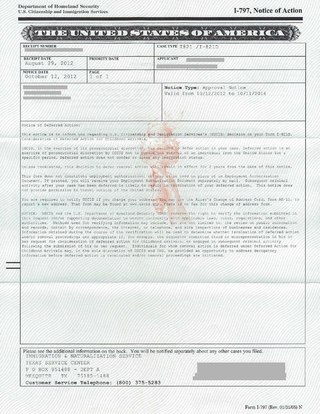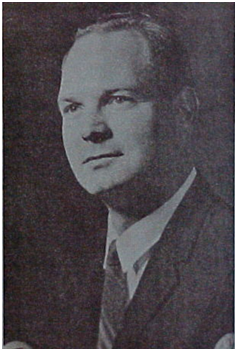Related Research Articles
The National Security Entry-Exit Registration System (NSEERS) or INS Special Registration was a system for registering certain non-citizens within the United States, initiated in September 2002 as part of the War on Terrorism. Portions were suspended as of April 27, 2011, and the entirety of the regulation was removed on December 23, 2016.

A green card, known officially as a permanent resident card, is an identity document which shows that a person has permanent residency in the United States. Green card holders are formally known as lawful permanent residents (LPRs). As of 2019, there are an estimated 13.9 million green card holders, of whom 9.1 million are eligible to become United States citizens. Approximately 18,700 of them serve in the U.S. Armed Forces.

The Immigration Reform and Control Act was passed by the 99th United States Congress and signed into law by U.S. President Ronald Reagan on November 6, 1986.
Reforming the immigration policy of the United States is a subject of political discourse and contention. Immigration has played an essential part in American history, as except for the Native Americans, everyone in the United States is descended from people who migrated to the United States. Some claim that the United States maintains the world's most liberal immigration policy.

The Development, Relief, and Education for Alien Minors Act, known as the DREAM Act, is a United States legislative proposal to grant temporary conditional residency, with the right to work, to illegal immigrants who entered the United States as minors—and, if they later satisfy further qualifications, they would attain permanent residency.

Foreign nationals (aliens) can violate US immigration laws by entering the United States unlawfully or lawfully entering but then remaining after the expiration of their visas, parole, or temporary protected status. Illegal immigration has been a matter of intense debate in the United States since the 1980s.

A Form I-766 employment authorization document or EAD card, known popularly as a work permit, is a document issued by the United States Citizenship and Immigration Services (USCIS) that provides temporary employment authorization to noncitizens in the United States.
During the 18th and most of the 19th centuries, the United States had limited regulation of immigration and naturalization at a national level. Under a mostly prevailing "open border" policy, immigration was generally welcomed, although citizenship was limited to “white persons” as of 1790, and naturalization subject to five year residency requirement as of 1802. Passports and visas were not required for entry to America, rules and procedures for arriving immigrants were determined by local ports of entry or state laws, and processes for naturalization were determined by local county courts.
In United States administrative law, deferred action is an immigration classification which the executive branch can grant to illegal immigrants. This does not give them legal status, but can indefinitely delay their deportation. Deferred action is an exercise of the executive branch's enforcement discretion and was first publicly defined in a 1975 administrative guidance document published by the Immigration and Naturalization Service.
There are thought to be over half a million undocumented immigrants residing in New York City. They come from many parts of the world, especially Latin America, Asia, Eastern Europe, and the Caribbean. About 70% of them have paid work, in catering, construction, retail, driving, cleaning, and many other trades; at least in catering, their wages tend to be lower than those of comparable workers.

Deferred Action for Childhood Arrivals, colloquially referred to as DACA, is a United States immigration policy that allows some individuals with unlawful presence in the United States after being brought to the country as children to receive a renewable two-year period of deferred action from deportation and become eligible for an employment authorization document in the U.S. To be eligible for the program, recipients cannot have felonies or serious misdemeanors on their records. Unlike the proposed DREAM Act, DACA does not provide a path to citizenship for recipients. The policy, an executive branch memorandum, was announced by President Barack Obama on June 15, 2012. This followed a campaign by immigrants, advocates and supporters which employed a range of tactics. U.S. Citizenship and Immigration Services (USCIS) began accepting applications for the program on August 15, 2012.

Deportation and removal from the United States occurs when the U.S. government orders a person to leave the country. In fiscal year 2014, Immigration and Customs Enforcement conducted 315,943 removals. Criteria for deportations are set out in 8 U.S.C. § 1227.
Deferred Action for Parents of Americans and Lawful Permanent Residents (DAPA), sometimes called Deferred Action for Parental Accountability, was a planned United States immigration policy to grant deferred action status to certain undocumented immigrants who have lived in the United States since 2010 and have children who are either American citizens or lawful permanent residents. It was prevented from going into effect. Deferred action would not be legal status but would come with a three-year renewable work permit and exemption from deportation. DAPA was a presidential executive action, not a law passed by Congress.
United States v. Texas, 579 U.S. ___ (2016), is a United States Supreme Court case regarding the constitutionality of the Deferred Action for Parents of Americans (DAPA) program.
The Legal Immigration Family Equity Act of 2000, also known as the LIFE Act and as the Legal Immigration and Family Equity Act, along with its Amendments, made some changes to laws surrounding immigration for family members of United States citizens and Lawful Permanent Residents, as well as people eligible for employment-based immigrant visas, in the direction of making it easier for family members and immigrant workers to move to and adjust status within the United States. It was passed on December 21, 2000, as title XI of Pub. L. 106–553 (text)(PDF).
Voluntary departure in the Immigration and Nationality Act (INA) of the United States is a legal remedy available to certain aliens who have been placed in removal proceedings by the former U.S. Immigration and Naturalization Service (INS) or the now Department of Homeland Security (DHS).
The Priority Enforcement Program is a program by U.S. Immigration and Customs Enforcement (ICE), the agency responsible for immigration enforcement in the interior of the United States, under the U.S. Department of Homeland Security (DHS). PEP was an ICE program that worked with state and local law enforcement to identify illegal aliens who come in contact with state or local law enforcement, and remove those who are removable. PEP was announced by DHS Secretary Jeh Johnson in a November 20, 2014 memo as a replacement for Secure Communities (S-COMM). It builds on an updated list of immigration enforcement priorities released in another memo by Johnson issued on the same day.

Alan C. Nelson (1933-1997) was a Commissioner of the Immigration and Naturalization Services (INS) under the administration of then United States President Ronald Reagan, and co-author of the original proposal behind California Proposition 187.
Federal policy oversees and regulates immigration to the United States and citizenship of the United States. The United States Congress has authority over immigration policy in the United States, and it delegates enforcement to the Department of Homeland Security. Historically, the United States went through a period of loose immigration policy in the early-19th century followed by a period of strict immigration policy in the late-19th and early-20th centuries. Policy areas related to the immigration process include visa policy, asylum policy, and naturalization policy. Policy areas related to illegal immigration include deferral policy and removal policy.

The U.S. Citizenship Act of 2021 was a legislative bill that was proposed by President Joe Biden on his first day in office. It was formally introduced in the House by Representative Linda Sánchez. It died with the ending of the 117th Congress.
References
- 1 2 3 4 5 6 7 8 Pear, Robert (October 22, 1987). "U.S. May Let Some Illegals Stay If Relatives Qualify for Amnesty". The New York Times . Retrieved August 3, 2017.
- 1 2 3 4 5 Getlin, Josh (October 22, 1987). "Ineligible Children Face Deportation, INS Says: Such Offspring Can Remain Only if Both Parents Qualify for Amnesty; Spouses Also May Be Ejected". Los Angeles Times . Retrieved August 3, 2017.
- ↑ Sources
- "Interpreter releases: report and analysis of immigration and nationality law" (PDF). February 5, 1990. Retrieved February 22, 2017.
- "New Measure Opens the Door a Bit Wider to Aliens". The New York Times . Associated Press. February 3, 1990. Retrieved August 3, 2017.
- Howe, Marvine (March 5, 1990). "New Policy Aids Families of Aliens". The New York Times . Retrieved August 3, 2017.
- Ramos, George (February 15, 1990). "Immigrants Cautioned on INS 'Family Fairness' Plan". Los Angeles Times . Retrieved August 3, 2017.
- Guendelsberger, John W. (1992). "Family Fairness: A Status Report". International Migration Review. 15: 45–57. JSTOR 23143114.
- "Statement of the American Immigration Council submitted to the Committee on the Judiciary of the U.S. House of Representatives hearing on "The Unconstitutionality of Obama's Executive Actions on Immigration"" (PDF). February 25, 2015. Retrieved February 22, 2017.
- 1 2 3 4 5 6 7 8 9 10 11 "Reagan-Bush Family Fairness: A Chronological History". American Immigration Council. December 9, 2014. Retrieved February 5, 2017.
- 1 2 Blackman, Josh (April 21, 2016). "More on Family Fairness" . Retrieved February 21, 2017.
- ↑ Jones, Jack (April 9, 1987). "'Favor the Alien' : Mahony Urges Broad INS View of Amnesty". Los Angeles Times . Retrieved August 3, 2017.
- 1 2 "Statement of the American Immigration Council submitted to the Committee on the Judiciary of the U.S. House of Representatives hearing on "The Uncostitutionality of Obama's Executive Actions on Immigration"" (PDF). February 25, 2015. Retrieved February 22, 2017.
- 1 2 3 4 5 Farley, Robert (November 21, 2014). "Obama's Actions 'Same' as Past Presidents?". FactCheck. Retrieved February 22, 2017.
- ↑ Guendelsberger, John W. (1992). "Family Fairness: A Status Report". International Migration Review. 15: 45–57. JSTOR 23143114.
- ↑ "A Better Fate for Split Families : INS, Tangled in Rules, Misses the Purpose of Amnesty". Los Angeles Times . November 5, 1987. Retrieved August 3, 2017.
- ↑ Tumulty, Karen; Johnston, Ostwald (December 18, 1987). "Panel Supports Splitting Up Alien Families". Los Angeles Times . Retrieved August 3, 2017.
- 1 2 3 "Interpreter releases: report and analysis of immigration and nationality law" (PDF). February 5, 1990. Retrieved February 22, 2017.
- ↑ "New Measure Opens the Door a Bit Wider to Aliens". The New York Times . Associated Press. February 3, 1990. Retrieved August 3, 2017.
- ↑ Howe, Marvine (March 5, 1990). "New Policy Aids Families of Aliens". The New York Times . Retrieved August 3, 2017.
- ↑ Ramos, George (February 15, 1990). "Immigrants Cautioned on INS 'Family Fairness' Plan". Los Angeles Times . Retrieved August 3, 2017.
- 1 2 "IMPACT OF THE IMMIGRATION ACT OF 1990, FAMILY UNITY PROVISIONS, ON MEDI-CAL ELIGIBILITY". California Department of Health Care Services. March 1, 1993. Retrieved August 3, 2017.
- ↑ "24.4 Family Unity Program". United States Citizenship and Immigration Services . Retrieved August 3, 2017.
- ↑ Lind, Dara (November 20, 2014). "Did George H.W. Bush really pave the way for Obama on immigration?". Vox. Retrieved August 3, 2017.
- ↑ Fitz, Marshall (December 15, 2014). "The Bush Family Fairness Plan Is the True Precursor to the President's Executive Actions on Immigration". Huffington Post .
- ↑ Noferi, Mark (October 2, 2014). "When Reagan and GHW Bush took bold executive action on immigration". The Hill . Retrieved February 5, 2016.
- ↑ Blackman, Josh (January 6, 2015). "The Constitutionality of DAPA Part I: Congressional Acquiescence to Deferred Action". SSRN 2545544.
- ↑ Margulies, Peter (April 21, 2016). "Peter Margulies -- DAPA and a Pragmatic View of Work Authorization and Family Fairness: Reply to Marty Lederman" . Retrieved August 3, 2017.